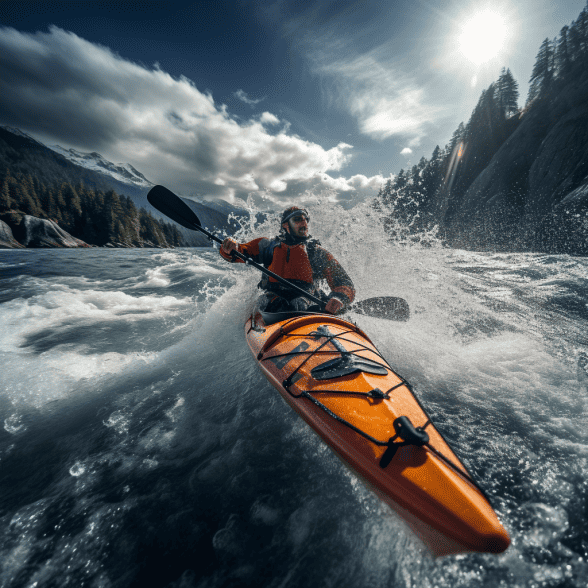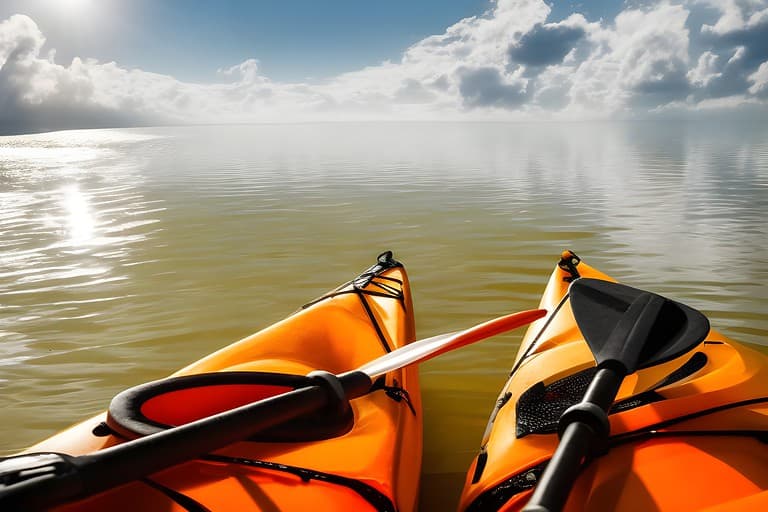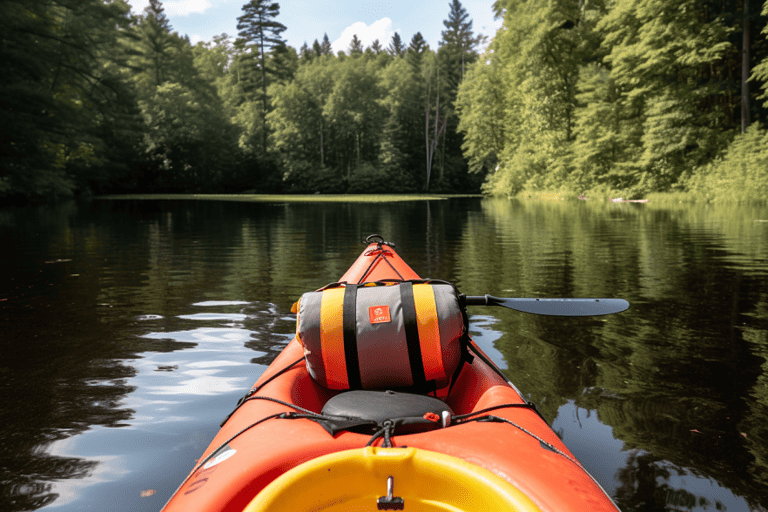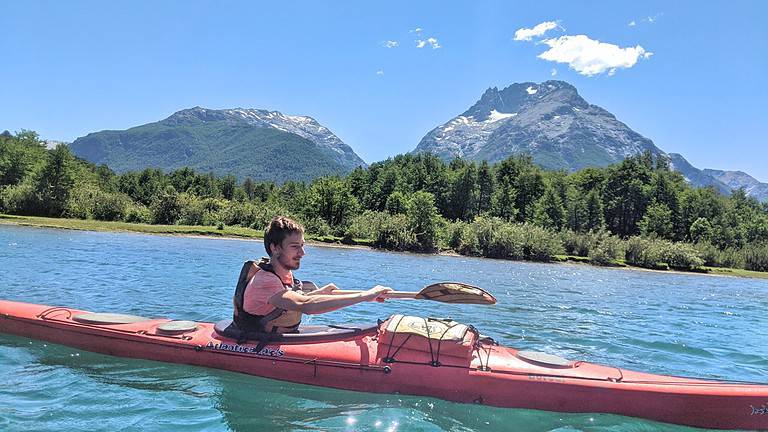Conquer the Waves: Kayak Stability Uncovered
Welcome fellow kayakers! Learn to Conquer the Waves within this post. We’re here to dive into the fascinating world of kayak stability and explore the intricate balance between primary and secondary stability. Strap on your life jackets and get ready for a wild ride as we navigate through the technicalities of this topic.
Kayak stability, oh, what a paradoxical concept it is! Picture this: you’re floating peacefully on calm waters, feeling confident in your kayak’s primary stability, when suddenly a wave comes crashing from nowhere, challenging your equilibrium. It’s moments like these that truly test our understanding of stability.
In this article, we’ll break down the basics of kayak stability and delve into the nuances of primary and secondary stability. Primary stability refers to how stable a kayak feels initially, while secondary stability determines its ability to recover from leaning or tipping. It’s all about finding the perfect harmony between feeling secure in calm conditions and handling unexpected challenges.
But wait! Before we embark on this educational journey, let’s remember safety considerations. Understanding kayak stability isn’t just about having fun and ensuring our well-being on the water.
So buckle up (or tighten those straps) as we explore the depths of kayak stability together. Get ready to become masters of balance and conquer any waves that come our way. Let’s embrace our sense of belonging in this beautiful community united by our love for kayaking!
Key Takeaways
- Primary stability is determined by hull shape, width, and weight distribution.
- Engaging core muscles and maintaining an upright posture helps improve balance and distribute weight evenly.
- Secondary stability is important for recovering from leaning or tipping and involves techniques such as body positioning, edging, sculling brace, and hip flicks.
- Finding the right balance between agility and stability is crucial for navigating challenging waters.
To better understand Conquer the Waves: The Basics of Kayak Stability
Understanding the basics of kayak stability is crucial for any paddler, as it allows us to confidently navigate different water conditions using our primary and secondary stability. Assessing stability and improving balance are two key components of understanding kayak stability.
Assessing stability involves evaluating how stable a kayak feels when we are sitting in it. It is important to consider factors such as the width and shape of the hull, as well as our own body position and weight distribution. A wider hull generally provides more initial stability, while a narrower one may feel less stable at first but can offer better performance in rougher waters. We can choose a kayak that suits our skill level and intended use by assessing these factors.
Improving balance is essential for maintaining stability while kayaking. This involves developing core strength and practicing proper paddling techniques. By engaging our core muscles and maintaining an upright posture, we can distribute our weight evenly across the kayak and enhance our overall balance. Regular practice on calm waters will help us develop a sense of control over the kayak’s movements.
Transitioning into the subsequent section about ‘primary stability explained,’ it is important to understand that primary stability refers to how stable a kayak initially feels when we first get into it or when we sit in calm waters. It determines how easy or difficult it is for the kayak to tip from side to side. Now let’s delve deeper into primary stability and its significance in kayaking.
Primary Stability Explained
When discussing primary stability, we refer to a kayak’s initial stability. It is defined by the kayak’s ability to resist tipping and maintain an upright position on calm water. Assessing primary stability involves analyzing factors such as hull shape, width, and design elements that contribute to a stable platform for paddling.

Definition and Characteristics
Explore the world of kayak stability by delving into the definition and unique characteristics that make it as thrilling as riding a wave. Understanding kayak stability is essential for any paddler seeking to confidently navigate different water conditions. Here are three key aspects to consider:
- Balance: Achieving a stable kayak requires finding the perfect equilibrium between the boat’s width, length, and hull shape. A wider kayak tends to have better initial stability, making it easier to stay upright when paddling in calm waters.
- Center of Gravity: The position of your body affects stability. Keeping your center of gravity low and centered helps maintain balance, especially when encountering waves or choppy waters.
- Hull Design: The shape of a kayak’s hull greatly influences its stability characteristics. Rounded hulls offer excellent secondary stability, allowing experienced paddlers to lean into turns without tipping over.
Understanding these factors affecting stability will provide a solid foundation for assessing primary stability in kayaks. Now let’s explore how to assess primary stability and further enhance our paddling skills.
How to Assess Primary Stability
To assess the primary stability of your kayak, imagine yourself sitting in the cockpit and feeling the solid connection between your body and the water as if you’re gliding effortlessly over calm, glassy surfaces. Assessing techniques for primary stability involve evaluating factors such as hull shape, width, and weight distribution. These factors determine how stable the kayak feels when upright on calm waters. To help you understand these concepts better, let’s take a closer look at some key factors that contribute to primary stability:
| Factors | Description |
| Hull Shape | The shape of the kayak’s bottom affects its stability. Flat-bottomed kayaks provide more initial stability than rounded or V-shaped hulls. |
| Width | Wider kayaks tend to have better primary stability because they offer more surface area contacting with the water. |
| Weight Distribution | Proper weight distribution can enhance primary stability by keeping the center of gravity lower. |
By understanding these assessing techniques and primary stability factors, we can better appreciate how our kayak performs on different types of waters. Moving forward into our exploration of secondary stability, we will delve into another important aspect of kayak stability.
Secondary Stability Explored
Contrasting primary stability, secondary stability creates a thrilling sense of anticipation and vulnerability as the kayak tilts on the edge of balance. It is crucial to understand secondary stability techniques to navigate more challenging waters with confidence. Here are four key aspects to consider:
- Body Positioning: Proper body positioning is essential for maintaining secondary stability. By keeping your torso centered over the kayak’s widest point, you can distribute your weight evenly and maintain control when the kayak starts to tilt.
- Edging Techniques: Edging refers to purposely tilting the kayak on its side by shifting your weight or adjusting your hips. This technique allows for improved maneuverability and better control in rough water conditions.
- Sculling Brace: The sculling brace is a technique used to support yourself using the paddle while leaning away from the direction of the tilt. This helps counterbalance the force acting on the kayak and maintains stability.
- Hip Flicks: Hip flicks involve engaging your core muscles and quickly rotating your hips to shift your weight and regain balance in response to unexpected movements or waves.
Despite its importance, there are common misconceptions about secondary stability that can lead to confusion. Many people mistakenly believe that a wider kayak automatically translates into better secondary stability, but this is not always true. Factors such as hull shape, rocker profile, and individual paddler skills also play significant roles.
Understanding these techniques and dispelling misconceptions about secondary stability will enable us to find the right balance between exhilaration and control in our kayaking adventures.
Finding the Right Balance
Maintaining a harmonious equilibrium between agility and stability is essential for navigating challenging waters in your kayak. Finding the right balance between these two factors can greatly enhance your kayaking experience and ensure you stay safe on the water. When it comes to maintaining equilibrium, stability control plays a crucial role.
Good stability control allows you to maintain balance in various conditions, such as rough waters or maneuvers. It enables you to adapt quickly to environmental changes without losing control of your kayak. By understanding how to manage your kayak’s primary and secondary stability effectively, you’ll be able to navigate with confidence and precision.

The importance of stability control cannot be overstated. It enhances your overall paddling performance and minimizes the risk of capsizing or falling out of your kayak. Properly managing both primary and secondary stability ensures that you can easily handle different situations, whether maneuvering through tight spaces or dealing with strong currents.
To maintain equilibrium, developing a strong core and practicing proper body positioning techniques while paddling is important. This will help distribute your weight evenly throughout the kayak, improving its overall stability. Additionally, using proper paddle strokes and maintaining an active stance will further contribute to maintaining balance and control.
Maintaining equilibrium by effectively managing stability control is vital for successful kayaking. By understanding and practicing techniques that optimize both primary and secondary stability, you’ll be able to navigate challenging waters confidently. However, it’s also important to consider safety considerations when venturing out onto the water.
Safety Considerations
When it comes to kayaking, understanding the impact of stability on safety is crucial. We must consider the precautions and best practices for ensuring a safe experience on the water. By analyzing the stability of our kayaks and implementing proper techniques, we can minimize the risk of accidents and ensure a smooth and secure journey.
Understanding the Impact of Stability on Safety
To ensure your safety on the water, it’s important to understand how kayak stability can impact your overall experience. A kayak’s primary and secondary stability plays a crucial role in maintaining balance while paddling. Primary stability refers to the initial stability of a kayak when it is at rest or in calm waters, while secondary stability pertains to its ability to remain stable when subjected to external forces such as waves or currents. A kayak with good primary stability provides beginners with confidence and ease of maneuverability, making it less likely for them to tip over. On the other hand, kayaks with high secondary stability are more suitable for experienced paddlers who encounter rougher conditions. Understanding these different types of stability helps you choose the right kayak for your skill level and allows you to make safer decisions on the water. Moving forward into precautions and best practices for kayaking, it’s essential to be aware of potential risks and take necessary measures for a safe journey.
Precautions and Best Practices for Kayaking
One key aspect of kayaking safety is awareness of potential risks and taking necessary precautions for a smooth and enjoyable journey on the water. Preventing capsizing and maintaining balance are crucial in ensuring a safe kayaking experience. To help you understand how to achieve this, let’s take a look at some precautions and best practices:
| Precautions | Best Practices | Equipment |
| 1. Check weather conditions before heading out | 1. Keep your body centered and relaxed | 1. Use a paddle leash to prevent losing your paddle |
| 2. Wear a personal flotation device (PFD) at all times | 2. Practice proper paddling technique | 2. Attach float bags to provide additional stability |
| 3. Inform someone about your trip plan and expected return time | 3. Maintain an upright posture while paddling | 3. Consider using outriggers for added stability |
Following these precautions, practicing good technique, and using appropriate equipment can greatly reduce the risk of capsizing and maintaining balance throughout your kayaking journey, ensuring an enjoyable experience on the water while prioritizing safety.
Frequently Asked Questions
What are the different types of kayak stability?
Kayak stability is crucial for a smooth and safe paddling experience. To maintain stability, proper body posture is of utmost importance. Maintaining an upright position with our core engaged creates a strong connection between the kayak and our body, enhancing stability. Techniques such as bracing and edging can greatly improve kayak stability in rough water conditions. These techniques allow us to adjust the kayak’s angle and distribute weight effectively, ensuring a stable ride even in challenging waters.
How does kayak design affect stability?
The role of hull shape in kayak stability is crucial. A more comprehensive, flatter hull provides more primary stability, making it easier to balance and less likely to tip over. On the other hand, a narrower V-shaped hull offers more excellent secondary stability, allowing for better maneuverability in rough water conditions. Additionally, weight distribution plays a significant role in kayak stability. Placing more weight toward the center improves overall stability, while uneven weight distribution can negatively affect balance and control.
Are wider kayaks more stable than narrower ones?
Regarding kayak stability, wider kayaks generally offer more stability than narrower ones. This is due to a combination of factors, including weight distribution and hull shape. Wider kayaks provide a larger base for better balance and can handle weight shifts more effectively. However, it’s important to note that wind and currents can still impact the stability of any kayak, regardless of its width. Therefore, proper technique and awareness are crucial for maintaining stability on the water.
Can kayak stability be improved with accessories or modifications?
To improve kayak stability, we can consider weight distribution and stabilizing outriggers. Proper weight distribution is essential for stability, as it helps maintain balance in the water. Evenly distributing our weight can prevent tipping and increase overall stability. Additionally, stabilizing outriggers can provide added support and reduce the risk of capsizing. These accessories help create a wider base for the kayak, enhancing stability and providing a sense of security while paddling.
What are some common mistakes beginners make that affect kayak stability?
Oh boy, where do I begin with the typical mistakes beginners make that affect kayak stability? Let’s start with the paddling technique. Some rookies think they’re auditioning for a synchronized swimming team with their wild and erratic strokes. Newsflash: it’s not a dance routine! And don’t even get me started on improper weight distribution. It’s like they’re trying to turn their kayak into a seesaw! Trust me, folks, if you want stability, learn to paddle with finesse and distribute your weight evenly.
Frequently Asked Questions
Q1: What are the different types of kayak stability?
A: Kayak stability is divided into primary and secondary stability. Primary stability refers to a kayak’s initial stability when it is at rest or in calm waters. Secondary stability pertains to its ability to remain stable when subjected to external forces such as waves or currents.
Q2: How does kayak design affect stability?
A: The kayak’s design, especially its hull’s shape, plays a crucial role in its stability. A wider, flatter hull provides more primary stability, making it easier to balance and less likely to tip over. On the other hand, a narrower V-shaped hull offers more excellent secondary stability, allowing for better maneuverability in rough water conditions.
Q3: Are wider kayaks more stable than narrower ones?
A: Generally, wider kayaks offer more stability than narrower ones due to a larger base for better balance and the ability to handle weight shifts more effectively. However, wind and currents can still impact the stability of any kayak, regardless of its width.
Q4: Can kayak stability be improved with accessories or modifications?
A: Kayak stability can be improved with certain accessories or modifications. For instance, stabilizing outriggers can provide added support and reduce the risk of capsizing. Proper weight distribution, achieved through careful placement of gear and equipment, can also enhance stability.
Q5: What are some common mistakes beginners make that affect kayak stability?
A: Common mistakes beginners make include improper paddling technique and uneven weight distribution. These can lead to instability and increase the risk of capsizing. It’s important for beginners to learn proper paddling techniques and how to distribute their weight evenly for optimal stability.
Conclusion
In conclusion, understanding the nuances of kayak stability is crucial for a safe and enjoyable paddling experience. We can confidently navigate through choppy waters by grasping the concepts of primary and secondary stability. It’s like finding our sea legs, allowing us to find the sweet spot between stability and maneuverability. However, let’s not forget that safety should always be our top priority. So before embarking on any kayaking adventure, ensure you have the necessary skills, equipment, and knowledge to ride the waves smoothly.






